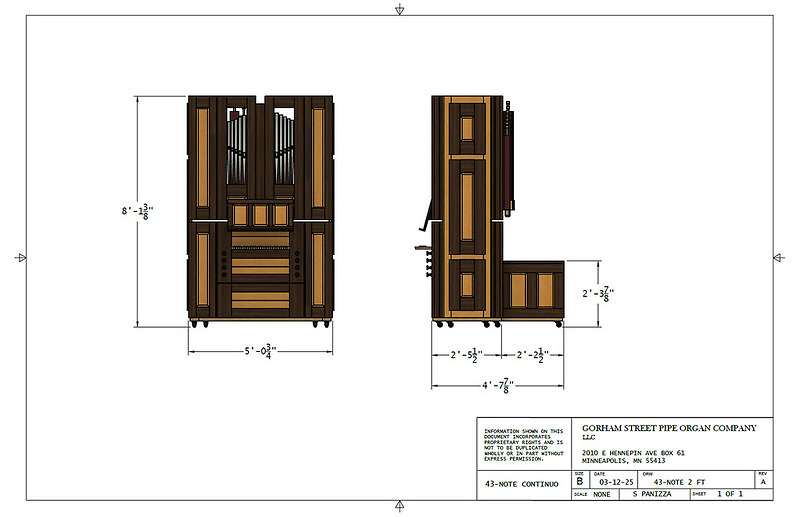Continuo |
by Steve Panizza
The description of a post-pandemic course offering at the University of Minnesota titled "Design for a Disrupted World" motivated me to innovate new designs for a family of 43-note cabinet organs. I call this my collaborative classical coffee shop approach to the organ.
I recently finished the design work for a 43-note early 19th-century continuo organ that cost-effectively repurposes available material from the first organ I built into a collaborative instrument for accompaniment, one that will likely benefit an alternative-use art, atrium, performance, or liturgical space.
The idea behind my Gorham Street Pipe Organ Company was to create innovative post-pandemic design. I accomplished that by creating the 43-note continuo concept, an instrument built to accompany instruments and voices and promote collaborative use.
The 43-note continuo evolves tradition by recycling old pipework with new to produce a blended, culturally eclectic tonal design. The instrument is cost-sustainable and space-efficient. And by adding a mobile platform, the 43-note is location agnostic.
Think of the organ in terms of tradition. Tradition, though, must evolve to remain relevant. So please think of this 43-note musician's tool in terms of what it can do, not what it cannot do.
With a continuo design architecture that recycles old organ pipes with new, I evolved tradition to produce a 43-note instrument with a sustainable cost of ownership and the innate ability to invite a diverse set of musicians to participate in its use.
In designing to employ Victorian pipes of broader scale, I combine timbres through the blended use of recycled pipework from eras past to produce tonal diversity in an instrument that maintains a resplendent and unified plenum tone.
With the simplicity of a proven mechanical key and stop action and with everything inside comfortably accessible and maintainable, the 43-note continuo undeniably offers a sustainable cost of ownership, providing a community of musicians with affordable access to the pipe organ they might not otherwise have.
The idea for a 43-note blended 19th-century continuo innovatively defines the Gorham Street Pipe Organ Company. The 43-note concept allows me to combine a competent and functional instrument with sustainability.
A commission worth pursuing, I welcome inquiries.
Bourdon 8' Bass (notes 06 - 17, stopped wood)
Bourdon 8' Discant (notes 18 - 48)
Viol 8' Discant (notes 18 - 48)
Flûte 4' Bass (notes 06 - 17, stopped wood)
Prestant 4' Discant (notes 18 - 48)
Flûte ouverte 4' Discant (notes 18 - 48)
Octav 2' (notes 06 - 48)
Quint 1 1/3' (notes 06 - 48)
Corneta I-II (notes 06 - 48)
This example specification, a culturally eclectic design, combines French and German influences, while the Corneta is Spanish. It also represents my experience with a mid-nineteenth-century Ducroquet. The Flûte ouverte 4' could as well have triangular cross sections.
As Antoine de Saint-Exupéry is said to have said, "Perfection is achieved, not when there is nothing more to add, but when there is nothing left to take away."







